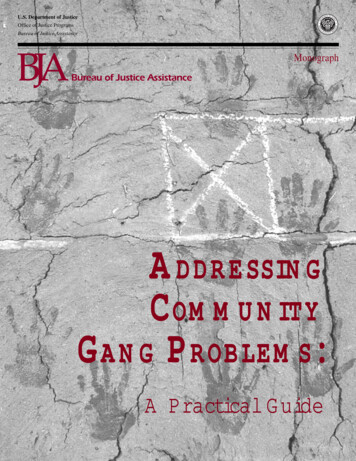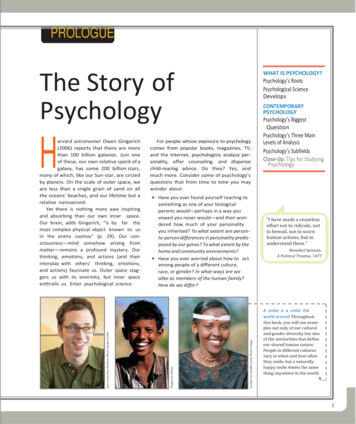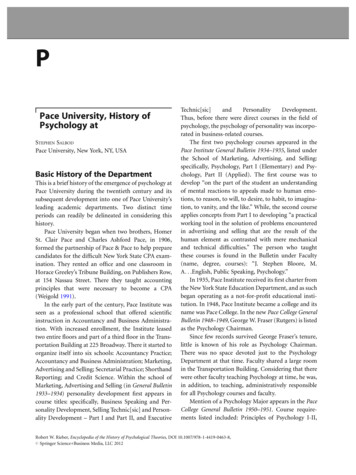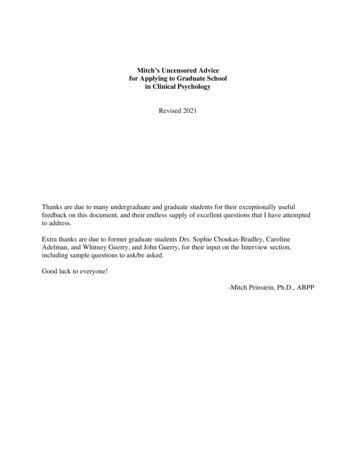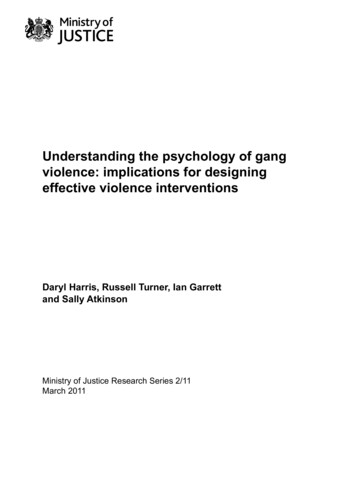
Transcription
Understanding the psychology of gangviolence: implications for designingeffective violence interventionsDaryl Harris, Russell Turner, Ian Garrettand Sally AtkinsonMinistry of Justice Research Series 2/11March 2011
Understanding the psychology of gangviolence: implications for designingeffective violence interventionsDaryl Harris, Russell Turner, Ian Garrett and Sally AtkinsonThis information is also available on the Ministry of Justice tm
Analytical Services exists to improve policy making, decision taking and practiceby the Ministry of Justice. It does this by providing robust, timely and relevant dataand advice drawn from research and analysis undertaken by the department’sanalysts and by the wider research community.DisclaimerThe views expressed are those of the authors and are not necessarily shared by the Ministryof Justice (nor do they represent Government policy). Crown Copyright 2011.You may re-use this information (not including logos) free of charge in any format or medium,under the terms of the Open Government Licence.To view this licence, visit ment-licence/or write to the Information Policy Team, The National Archives, Kew, London TW9 4DU,or e-mail: psi@nationalarchives.gsi.gov.uk.First Published 2011ISBN: 978-1-84099-458-2
ContentsExecutive odological limitations22353Main findingsWhat is a gang?What factors motivate individuals to join a street gang?What factors maintain gang membership in prison and the community?What factors are associated with desistance from gang involvement/membership?How does gang membership influence an individual’s use of violence?1418Practical oughcare222223244References8891125
Executive summaryThis report outlines the findings of an exploratory project seeking greater understanding ofthe psychological processes contributing to violence carried out by prisoners identified asstreet-gang members. Specifically the research aims to provide information relating to thefollowing questions:1.What is a gang?2.What factors motivate individuals to join a street gang?3.What factors maintain gang membership in prison and the community?4.What factors are associated with desistance from gang involvement/membership?5.How does gang membership influence an individual’s use of violence?The study employed a qualitative approach in which 44 male gang-affiliated prisonersconvicted of violent offences were interviewed about their own experiences and perceptionsof gang affiliation. Interpretative phenomenological analysis was used to identify themes thatemerged from participants’ accounts.What is a gang?Participants held different views about the nature of gangs and there was a lack ofconsensus about what constituted a gang.What factors motivate individuals to join a street gang?This study identified important psychological motivations ‘pulls’ contributing to gang affiliation.These included: the need and/or desire to make money; seeking protection against victimisation; gaining a sense of belonging or connectedness with others; and a means of achieving status and respect.What factors maintain gang membership in prison and the community?This research suggests that criminality reinforces gang affiliation and gang identity in severalways: criminal activity was positively reinforced by others in the gang, through praise,enhanced status, greater inclusion, and financial reward; criminality also reinforced gang affiliation by the avoidance of unwanted consequences,such as rejection from the gang or victimisation by others; territorial disputes maintained gang cohesion and justified the need to group together toprotect the gang’s territory.i
What factors are associated with desistance from gang involvement/membership?Some participants in the study described themselves as desisting from gang involvementas they matured and reflected on past behaviour. Some spoke about the positive impact ofacquiring a new role in life, such as becoming a father, in helping them to re-evaluate theirgang associations. Others identified feeling let down or abandoned by the group to whichthey belonged as a catalyst for re-evaluation.Some participants expressed a sense of wanting to be in control of change. However, thiswas sometimes linked with doubt about being able to change without positive support. Someof those who had completed accredited offending behaviour programmes reported personallybenefiting from them and provided examples of how their learning had helped them to avoidusing violence in prison.Participants often had positive plans for the future. However, these tended to sound likegeneral, simplified hopes that often overestimated the ease with which they would overcomepotential difficulties. Some participants discussed the risk of continued gang involvementif they returned to live in the same area on release. Finally, participants discussed howmembers of the criminal justice system might not acknowledge positive changes.How does gang membership influence an individual’s use of violence?Findings from this study suggest the meaning of violence for participants can be understoodunder the following themes:using pre-emptive violence to protect themselves from victimisation; a willingness to join in with violence to gain approval for inclusion in the group;using violence as a means of having fun or excitement;having a propensity for violence that existed before joining a gang;using violence to achieve and maintain status and respect;viewing violence as a necessary and acceptable means of making money and protecting‘business’ interests.Practical implicationsThe research highlighted a number of issues relevant to assessment and intervention withgang-affiliated offenders. It is important to explore an offender’s own sense of their involvement in collectiveoffending and avoiding labelling and simplistic assumptions about gangs.Assessments should include the full range of domains linked with gang affiliation.Personal motivations for affiliation may be closely linked to a gang member’s use ofviolence. Exploring these links may help to inform intervention.ii
There may be some differences in the criteria (and information) used across agenciesto prioritise offenders, which reinforces the importance of information sharing andcollaboration in assessment and management of risk.There can be significant rivalry and conflict both between and within gangs. This hasobvious implications for allocation of offenders to intervention groups.There can be considerable variation between different participants’ experience andsense of gang affiliation. Exploring and understanding these differences may help toinform and refine decisions about appropriate allocation.Motivation for the use of violence by gang-affiliated offenders overlaps considerablywith patterns of thinking linked with the use of violence in other violent offenders. Thissuggests that many gang members could benefit from the same interventions as thosedesigned for generally violent offenders, which focus on underlying values, beliefs, andexpectations about violence.Interventions focusing solely on facilitating exit from gangs are unlikely to reduceviolence risk in all gang-affiliated offenders. They should also explore (and address) thefull range of other factors linked with the offender’s use of violence.Offenders’ treatment needs and patterns of engagement might vary at differentdevelopmental points, which should be considered in treatment planning.Exploring personal motivations for joining and staying with street gangs might help toidentify ways of engaging offenders in intervention, and motivating them towards prosocial change.Becoming a father and disillusionment with gang life may be significant events thatsupport the process of exiting gangs and desisting from offending.Some offenders expressed a strong need for control over change, a mistrustful oranti-authority stance, and sensitivity to being labelled, stereotyped and/or judged. Itis important that facilitators and managers of interventions find ways of constructivelyworking with these issues.Potential barriers to successful resettlement include the absence of concrete andrealistic future plans, and an over-reliance on leaving the ‘home’ area as a strategy forovercoming barriers to resettlement.iii
1IntroductionThis report presents the main findings from a research study that was commissioned bythe Metropolitan Police Service, the National Offender Management Service (NOMS)Rehabilitation Services Group and the Home Office. It aims to develop an understandingof the psychological factors that contribute to violence carried out by prisoners identifiedas street-gang members. This is essentially an exploratory study. It aims to explore the linkbetween street gangs and violence and the implications of this for current violence reductionpractice in prison and the community.1
2MethodologyThis project is an exploratory study that seeks to add to the understanding of violence carriedout by prisoners identified as street-gang members. The over-arching aim is to identifypotential implications for improving existing violence reduction interventions for this group ofoffenders. The primary end-users of the research are staff within the criminal justice system,particularly practitioners advising on and/or working directly with offenders convicted of gangrelated violence. Current methods of practice within offender interventions are at the levelof individual or group work, and mainly rely on psychological techniques. In consequence,this research must be able to identify implications for practice at the level of individualpsychology. This research is viewed as an exploratory first step towards developing apsychological understanding of gangs at an individual level.SampleThe selection of participants for the field research involved two steps.The first step was to identify potential gang members. As noted above, this step focused onindividuals who were detained in custody at the time of research. Evidence of gang affiliationwas assessed against the Hallsworth and Young (2006) definition of gang membership.Hallsworth and Young define a gang “ as a relatively durable, predominantly street-basedgroup of young people who see themselves (and are recognised by others) as a discerniblegroup for whom crime and violence is intrinsic to identity and practice”. Candidates withoutsubstantiated evidence of gang membership or association were removed from the sample.This step involved reviewing information held on a number of specified databases related toviolent gang-related offences in the Greater London area. The researchers noted that one ofthese databases prioritised gun crime, while another focused on so-called ‘Black-on-Black’crime. They also acknowledged that the sample extracted reflects the bias in the originalrecords, most notably on three variables: geography (London-based);index offence (gun-crime);ethnicity (Black).Although the Hallsworth and Young criteria were used to define the sample, one of theissues the study aimed to explore was participants’ own sense of their gang affiliation. Thisincluded considering their own definitions and orientation to what a gang is, and the extentthat they saw themselves as a gang member. The Hallsworth and Young ‘official’ definitionis seen as an important anchor point. This anchor provides an appropriate starting point foran explorative study because it clearly identifies the population being explored. At the timeof the research, the Hallsworth and Young definition was the operational definition in use bythe Metropolitan Police. Prison staff often consult police records in assessment of prisoners2
and in planning interventions with convicted offenders. Hence the sample obtained closelycorresponds to the intended end use of the research.The second step screened candidates for violence history. This involved screening outcandidates without either a violent index offence or evidence of prior violent offending.Violent offences included possession of a weapon. The study did not differentiate betweengang-related violence and general violence. This reflected two considerations. First, thisdistinction can be tenuous and difficult to make. Second, a principal focus of the study wason improving violence interventions for gang-affiliated offenders. These interventions do notroutinely distinguish between violence occurring in different contexts. Instead they aim toimprove understanding and management of risk factors contributing to the range of violentacts committed by an individual.The result of these two steps of sample selection produced a list of 150 convicted offenderswho were considered for recruitment as participants in the study.DesignInterpretative phenomenological analysis (IPA) was chosen as the underpinningmethodology. This is a qualitative approach developed within psychology by Smith (1996).It allows in-depth exploration at the individual level of the sense people make of theirexperiences, and is thus particularly suited to exploratory studies.IPA advocates purposive sampling, which means that the sample is chosen on its relevanceto the research aim (Smith and Osborn, 2008). In this case this is people in prison convictedof violent, gang-related offences, as it is these individuals for whom any implications forviolence reduction interventions will be relevant.There were two discrete phases to the field research. The first phase can be referred to as a full IPA study.The second phase can be considered an extension of the IPA method in keeping withqualitative psychological research principles.Both phases incorporated the collection of qualitative data through one-to-one interviews.The first phase of the field research involved conducting a series of open-ended interviewswith male gang-affiliated violent offenders currently serving prison sentences. It is importantto note that what was being sought was the participant’s own view of their experience.Interviews ranged between one and two hours and were digitally recorded and thentranscribed verbatim. Transcripts were analysed following IPA principles (Smith and Osborn,2008) and a set of four themes was produced.3
Self as protected & connected Self as feared, respected, & having statusSelf as money-maker: From survival to big businessThe changing self: Self as maturing, prison subject, and future selfEach theme had between 2 and 5 sub-themes, totalling 16 sub-themes. These themes werewritten up with substantial reference to interview extracts.The first phase of the field work was conducted during January 2009. Researchersapproached14 prisoners at three establishments, 1 adult and 2 juvenile prisons. Ofthese, seven declined, one was transferred, and six agreed to participate (an acceptancerate of 42%).Three of the six participants self-classified as ‘Black or Black British: Caribbean’ and threewere ‘Black or Black British: African’. Age at the time of interview ranged from 18 to 22 andthe mean age was 19.8. Five of the six were convicted for violent offences, ranging fromattempted murder to robbery. One participant was convicted of a serious sexual offence.Convictions were from the period May 2007 to August 2008 and age at the time of offenceranged from 16 to 19 (mean age 17.4). The number of previous convictions ranged fromone to ten (mean and median five). Offender Assessment System (OASys) scores were onlyavailable for one participant in this phase. At the time of interview, participants had been incustody between 5 and 20 months (mean 12.8 months).The second phase of the field research used an identical design to the first phase in anattempt to test the first phase themes as a way of understanding, with more members ofthe group under study. The first phase themes were revised based on the qualitative datafrom the second phase, and the themes of violence and of the phenomenon of the gangwere developed.The second phase of the field work was conducted during March and April 2009. Of theremaining 136 potential participants from the original sample list, 17 (12%) were deemed tobe impractical to reach due to single participants being in remote locations. A further 42 (31%of 136 potential participants) were unavailable for other reasons: 13 (10%) transferred during the field work;12 (9%) could not be located;9 (7%) were released during the field work;5 (4%) posed staff safety concerns;access to the prison was an issue for 3 (2%) participants.4
This left 77 potential participants. Of these, 39 declined to take part (including 1 whoinitially agreed but withdrew on the day), this being 29% of the original 136 but 51% ofthose approached. There were thus 38 participants, giving an acceptance rate of 49%. Themajority, 32 participants (84%) were in adult prisons, of which 4 (11%) were in high securityprisons. The remaining six participants (16%) were in juvenile prisons.As discussed earlier, the researchers expected that the composition of this sample wouldreflect the bias in the records from which it was drawn, particularly that it will predominantlycomprise Black offenders convicted of gun crime. In the second phase sample:31 participants (82%) self-classified as Black or Black British, comprising 17 (45%) of Caribbean origin, 10 (26%) of African origin, and 4 (11%) of other origins;3 participants (8%) were ‘White’, comprising 2 (5%) from outside the British Isles;2 participants (5%) were Asian;1 (3%) self-classified as ‘Mixed: White & Black Caribbean’;ethnicity information was missing for 1 (3%) participant.The majority, 36 participants (95%), were convicted for violent offences ranging from murderto robbery, of which 17 (45%) participants were convicted of possessing a weapon, and 4(11%) of the violent offences were violent acquisition, such as robbery. One participant (3%)was convicted of drug offences and one other of possessing criminal property. Convictionswere from the period October 2004 to November 2008. Age at first conviction ranged from 13to 39 (mean age 18.4, median 16), and 30% of participants were adults (18 and over) at firstconviction. The number of previous convictions per person ranged from 0 to 16, with 18% ofparticipants having 1 or no previous convictions, and 52% having 4 or fewer. The mean numberof convictions per person was 5.2 (median 4). OASys scores were missing for 14 (37%) ofparticipants. Available scores ranged between 19 and 116 with mean of 66 and median of 67.Age at the time of interview ranged from 20 to 56 with a mean age of 26.4 and a medianof 23. More than two-thirds of participants were in the age bracket 20 to 25. At the time ofinterview, participants had been in custody between 4 and 53 months (the mean and medianwere 25 months).Methodological limitationsThe limitations of the methodology can be discussed under three main headings: sampling;acceptance rates (self-selection);barriers to disclosure and engagement.5
The sample was drawn from existing records about violent gang-related offences. Bias in therecords has been noted in terms of geography, index offence, and ethnicity. What is not known,however, is the extent that the original 150 prisoners on the list, and thus those who wereinterviewed, are representative of the wider population of convicted violent gang members inprison. For example, a sample drawn from another city is firstly likely to have a differing ethniccomposition. The desk research discussed how the ethnic composition of gangs tends toreflect the ethnic composition of the areas where they are based. Secondly, it may be the casethat gangs have different experiences in different cities and regions. The themes would need tobe tested on a sample of convicted violent gang members from other cities.The researchers also noted that the original sample excluded high-level organised criminals(as defined by Hallsworth and Young, 2006). As a result application of the findings of thisstudy to organised crime should be approached with much caution.Finally, the researchers acknowledged that all members of the sample were held in custodyat the time of interviewing. This might impact on the generalisability of findings to gangaffiliated offenders ‘on the street’. However, they noted that there was a high degree ofoverlap in the findings of this study and other studies of gang members not in custody.Acceptance rates (the proportion of those asked who agreed to be interviewed) at the firstand second stage were 42% and 49% respectively. This gives a self-selecting sample. This iscommon in qualitative research. Indeed, it can be argued that it is necessary that somebodychooses, without incitement or reward, to participate in a research interview, otherwisetheir engagement in the interview is seriously compromised. However, this means that theresearch does not have information about those prisoners who chose not to participate, apartfrom that they did not differ in age. It is possible that their experiences of being in a gangcould differ from those who chose to be interviewed.The extent to which a participant engages in the interview is important to the quality ofthe interview. This is something that the researcher conducting the interview is able toadequately judge based on professional experience. However, several barriers to participantengagement in the interviews should be noted.The interviews were held within the prison environment and the research was being carriedout on behalf of the NOMS. Although participants were informed that the research teamwere independent researchers and were provided with information concerning anonymityand confidentiality, it seems unlikely that all participants would speak as freely as theymight to a friend in a home environment. As mentioned above participants self-selected tobe interviewed, without coercion or reward, and the interview only covered events alreadyknown to the criminal justice authorities. This was seen to minimise one potential barrier todisclosure, that of incriminating self or others, including being seen as a ‘grass’. It was also6
made clear in interview that participants could skip questions without explanation, as well aschoose not to be recorded. Furthermore, the IPA style of interviewing is open, curious, andsupportive in facilitating participants to explore their own sense of experiences and events.These approaches combined were viewed to minimise barriers to engagement.The research team comprised two White males and four White females. Given that thesample was predominantly Black, it may be possible that the ethnic difference was a barrierto engagement in the interviews.From the debrief discussions after the interviews, the research team felt that disclosureand engagement had not presented a problem in the interviews, and that engagementwas generally very good. It was felt that participants differed in terms of their willingness todiscuss potentially uncomfortable aspects of their experiences, but this was felt to reflectan ordinary spread one would expect, rather than a systematic issue with this sample.The wide-ranging experiences of the research team with different offender populations,in both research and practice, was essential to being confident about adequate levels ofengagement in interviews.The research aims concern implications for violence reduction interventions with similargroups, primarily in a prison environment. It can be argued that interventions staff are likely toget a similar level of engagement in interviews or treatment sessions to that achieved by theresearch team. This suggests that any gains in engagement attained by, for example, peerinterviewing and/or interviewing in home locations, would be negligible for the intended enduse of this research.7
3Main findingsThe findings from this report are discussed under five main research questions:1.What is a gang?2.What factors motivate individuals to join a street gang?3.What factors maintain gang membership in prison and the community?4.What factors are associated with desistance from gang involvement/membership?5.How does gang membership influence an individual’s use of violence?What is a gang?Participants had differing views on what they believed a gang to be. For some individualscollective offending was experienced as occurring in a context of closed groups of stable,supportive and cohesive ‘friendships’. These groups might or might not have a processof recruiting new members, and might or might not identify themselves as a ‘gang’. Otherparticipants described a sense of gangs as highly competitive, hierarchical structuresthat provide some level of exclusivity. For some participants affiliations were stronglytied to geographic territory, yet for others they were highly fluid and based on shiftinggeographical boundaries.These themes overlap to a large extent with information from previous research, whichsuggests that gangs can be fluid, flat in structure, stem from ordinary friendships, and havea relatively strong identity (Aldridge and Medina, 2007; Youth Justice Board, 2007; Marshall,Webb and Tilley, 2005; Mares, 2001). However, the above also suggests that practitionersneed to be careful about making assumptions about an offender’s own sense of theirgang affiliations. This includes being cautious about labelling offenders as gang members.One reason for this caution is that some of the participants in the field research activelyresisted the label ‘gang member’. Several of these participants refused to proceed until theinterviewer acknowledged their rejection of this label.One other issue complicating the understanding of gangs is the difficulty of translatingcommunity definitions of a ‘gang’ to custodial contexts. In these settings gangs have beendefined as “a cohesive group of prisoners (with a leader), whose criminal activities have anegative impact on the prisons that hold them” (Fong and Buentello, 1991; Huff, 1991), or as“a group of three or more prisoners whose behaviour has an adverse impact on the prisonthat holds them” (Wood, 2006).Most participants in the field research reported a sense that gangs or groups inside prisonwere different to those in the community. Participants generally talked about prison collectivesrepresenting groups of ‘ordinary’ friends who would protect and support each other. However,some participants also reported experiencing more predatory prison groups/gangs.8
Some interviewees suggested that gang-related disputes and rivalries might be carried overinto custody. Other participants suggested these disputes might be put aside. This in partreflected the need to band together with people from the same or similar home area. Thiswas seen as providing mutual protection, support, and the company of someone with asimilar background and cultural reference points. This need was reported to be particularlystrong when prisoners are held some distance from their home. For instance, membersof two rival London gangs who may have been in conflict in the community might form analliance if they were serving prison time in the north of England.What factors motivate individuals to join a street gang?Previous research suggests that the likelihood of gang affiliation is linked with the followingvariables: adolescence or young adulthood (Marshall, Webb and Tilley, 2005; Bennett andHolloway, 2004);being male (Marshall, Webb and Tilley, 2005; Bennett and Holloway, 2004);pro-criminal or absent role models (Aldridge and Medina, 2007; Sharp, Aldridge andMedina, 2006);having family members who belong to a gang (Youth Justice Board, 2007);having a perceived need for protection (Marshall, Webb and Tilley, 2005);being prone to sensation seeking and risk taking (Dawson, 2008);being part of a peer group that is characterised by strong territorial affiliations (Kintreaet al., 2008), criminality (Dawson, 2008), and a heightened need for respect and status(Toy and Stanko, 2008; Youth Justice Board, 2007);alienation and stress within family, education, and community contexts (Marshall, Webband Tilley, 2005; Smith and Bradshaw, 2005);living in a culture that strongly identifies success with material wealth (Toy and Stanko,2008; Youth Justice Board, 2007) and that holds negative attitudes to youth andmigrants (Building Bridges Project, 2008).The researchers noted that many of the factors associated with gang affiliation overlapwith factors that are predictive of general offending and violence. These include young age(Flood-Page et al., 2000), being male (Blanchette and Brown, 2006), having family members(Richardson and Budd, 2003) and peers (Youth Justice Board, 2007) who are involved inoffending, childhood experiences of neglect, inconsistent parenting or abuse (Farrington,2002), and poor educational performance (Rodger, Palmer and Mahon, 2007).Many of the studies reported above were sociological or criminological in focus. Thesestudies typically explore societal and community variables (Dutton, 2006). Decker and VanWinkel (1996) note that these variables are often interpreted as ‘pushing’ young peopletowards gang affiliation. However, they note that it is also important to recognise that gangmembership can exert a strong ‘pull’.9
The use of interpretative phenomenological analysis (IPA) in this study enabled detailedexploration of psychological motivations ‘pulls’ contributing to gang affiliation and the findingsboth support and extend previous research findings. Important psychological motivationscontributing to gang affiliation included: money;protection against victimisation;connectedness;status and respect.MoneyThe need and/or desire to make money were central to the experience of most participants.Interviews indicate that this need is linked with gang affiliation in several ways. First, someparticipants experienced gangs as a
Understanding the psychology of gang violence: implications for designing effective violence interventions Daryl Harris, Russell Turner, Ian Garrett . The primary end-users of the research are staff within the criminal justice system, particularly practitioners advising on and/or working directly with offenders convicted of gang-

